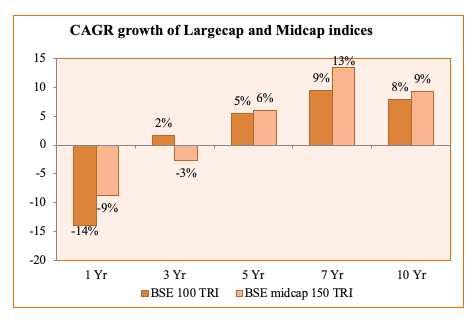Hello Readers!
Hope you all are safe from COVID-19!
Retirement planning, the most crucial part of one’s financial planning, advisor often advise people to start planning for their retirement, in the early years of their career. So that they can build the required corpus without any hurdles of other big responsibilities.
For Retirement planning, investors are suggested to invest in Equity Mutual funds. People who have long tenure for their investment, often invest in Large-cap Equity mutual funds, as they prefer to have low risk and stable portfolio. But sometimes alone large-cap Equity mutual fund is not enough to meet their retirement corpus, thus in this situation, they are advised to choose a higher risk-return proposition to bridge the gap. That’s when the option to invest a small portion of the portfolio in the midcap equity mutual fund is mooted.
But the question is does it make sense to invest in mid-cap Equity Funds?
MID-CAP EQUITY MUTUAL FUNDS
Large-cap Equity mutual funds invest in the top 100 companies in terms of market capitalization while Mid-cap equity mutual funds invest in the next 150 stocks in terms of market capitalization. Midcap funds invest 65 percent or more of their portfolio in such stocks.
Mid-cap Funds are known to deliver better growth potential to their investors than large-cap funds with less volatility and risk as compared to small-cap funds.
Midcap Equity index as measured by BSE Midcap 150 TRI has grown more than the BSE 100 TRI over the marginal long-term horizon of 10 years (see chart). Over a seven-year period, the midcap index grew by 13.4 percent as compared to 9.5 percent for the large-cap index.

Well, there is a strong correlation in the performance of large-cap and mid-cap stocks. However, in some instances it has also been observed that they move divergently, thus giving a good opportunity to investors to diversify their portfolio and protect losses.
It has been observed that midcaps stocks do well during the early bull phase of the market while underperforms during a bear phase. However, keep in mind that the index doesn’t necessarily reflect the results that the actual funds deliver.
WHY INCLUDE MID-CAP IN YOUR PORTFOLIO?
Large-cap funds are usually part of the leading business exhibitors that have a great ability to withstand the downtrends in the market. Also, they are mature business models with a large operating size, with contently moderate growth in revenues and profits.
On the other hand, Mid-cap companies grow at a rapid clip on a smaller base and by investing back their profits. Maybe the right financial support and business acumen, convert these Mid-cap companies into the large-cap. And this is where the opportunity for investors to grow their money lies.
By including Mid-cap Mutual funds in their portfolio, investors can get the benefit to grow their money along with the growth of Mid-cap Companies in large-cap. Historically, midcap companies, on average, have given better profits than large-caps resulting in better performance of their share prices.
RISKS
Mid-cap funds stand themselves safer than small-caps but at the same time, they are more volatile than large-caps. Thus, investors are suggested to have a minimum investment horizon of 7-10 years to makes use of the opportunity.
HOW TO CHOOSE FUNDS?
While choosing your mid-cap fund, not only analyze the past performance but do analyze the performance consistency– over five, seven, and 10-year period.
Picking out a market-beating mid-cap fund is a tough work due to a huge divergence in its performance. This is why when it comes to choosing actual funds mid-cap fund performance can be barely better than large-cap funds. Thus, an analysis of its performance consistency works better.
Midcap funds have the potential to improve overall portfolio returns and if you are able to absorb their higher volatility and stay invested during the down markets.
For any kind of query, you can contact us at Shri Ashutosh Securities Pvt Ltd., we are here to help you in any way possible.
Happy Investing!
(Mutual Fund investments are subject to market risk Illustrations are for example only, there is no guarantee of returns. Past performance is not an indicator/guarantee to future returns).